
In Buddhism, Avalokiteśvara, also known as Lokeśvara and Chenrezig, is a tenth-level bodhisattva associated with great compassion (mahakaruṇā). He is often associated with Amitabha Buddha. Avalokiteśvara has numerous manifestations and is depicted in various forms and styles. In some texts, he is even considered to be the source of all Hindu deities.
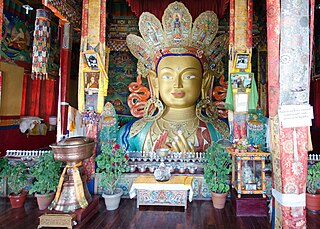
The vast majority of surviving Tibetan art created before the mid-20th century is religious, with the main forms being thangka, paintings on cloth, mostly in a technique described as gouache or distemper, Tibetan Buddhist wall paintings, and small statues in bronze, or large ones in clay, stucco or wood. They were commissioned by religious establishments or by pious individuals for use within the practice of Tibetan Buddhism and were manufactured in large workshops by monks and lay artists, who are mostly unknown. Various types of religious objects, such as the phurba or ritual dagger, are finely made and lavishly decorated. Secular objects, in particular jewellery and textiles, were also made, with Chinese influences strong in the latter.
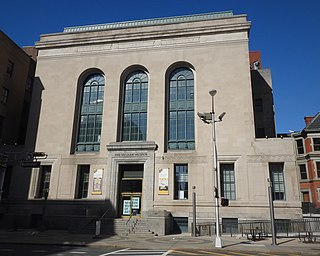
The Newark Museum of Art, formerly known as the Newark Museum, in Newark, Essex County, New Jersey is the state's largest museum. It holds major collections of American art, decorative arts, contemporary art, and arts of Asia, Africa, the Americas, and the ancient world. Its extensive collections of American art include works by Hiram Powers, Thomas Cole, John Singer Sargent, Albert Bierstadt, Frederick Church, Childe Hassam, Mary Cassatt, Edward Hopper, Georgia O'Keeffe, Joseph Stella, Tony Smith and Frank Stella.

A thangka is a Tibetan Buddhist painting on cotton, silk appliqué, usually depicting a Buddhist deity, scene, or mandala. Thangkas are traditionally kept unframed and rolled up when not on display, mounted on a textile backing somewhat in the style of Chinese scroll paintings, with a further silk cover on the front. So treated, thangkas can last a long time, but because of their delicate nature, they have to be kept in dry places where moisture will not affect the quality of the silk. Most thangkas are relatively small, comparable in size to a Western half-length portrait, but some are extremely large, several metres in each dimension; these were designed to be displayed, typically for very brief periods on a monastery wall, as part of religious festivals. Most thangkas were intended for personal meditation or instruction of monastic students. They often have elaborate compositions including many very small figures. A central deity is often surrounded by other identified figures in a symmetrical composition. Narrative scenes are less common, but do appear.

Mahākāla is a deity common to Hinduism and Buddhism.
Tibetan Americans are Americans of Tibetan ancestry. As of 2020, more than 26,700 Americans are estimated to have Tibetan ancestry. The majority of Tibetan Americans reside in Queens, New York.

Buddhist art is visual art produced in the context of Buddhism. It includes depictions of Gautama Buddha and other Buddhas and bodhisattvas, notable Buddhist figures both historical and mythical, narrative scenes from their lives, mandalas, and physical objects associated with Buddhist practice, such as vajras, bells, stupas and Buddhist temple architecture. Buddhist art originated in the north of the Indian subcontinent, in modern India, Pakistan and Afghanistan, with the earliest survivals dating from a few centuries after the historical life of Siddhartha Gautama from the 6th to 5th century BCE.
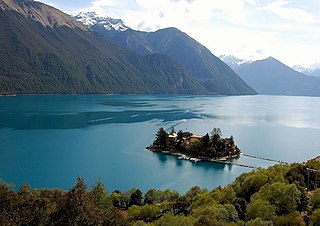
Tsozong Gongba Monastery is a small Tibetan Buddhism monastery in eastern Tibet. The monastery, founded in 1400, practices the Nyingma tradition. Tsozong Gongba is located on Tashi Island in the middle of Pagsum Lake in the Nyenchen Tanglha Mountains, part of Gongbo'gyamda County in Nyingchi Prefecture, Tibet Autonomous Region. Tsozong Gongba means "castle in the lake" in Tibetan. The monastery has four buildings situated around a small yard.

Buddhism in the Himachal Pradesh state of India of has been a long-recorded practice. The spread of Buddhism in the region has occurred intermediately throughout its history. Starting in the 3rd century BCE, Buddhism was propagated by the Maurya Empire under the reign of Ashoka. The region would remain an important center for Buddhism under the Kushan Empire and its vassals. Over the centuries the following of Buddhism has greatly fluctuated. Yet by experiencing revivals and migrations, Buddhism continued to be rooted in the region, particularly in the Lahaul, Spiti and Kinnaur valleys.

Lobsang Wangyal is a writer, social activist, photojournalist, and events producer, based in McLeod Ganj, Dharamshala, India. He has been a stringer reporter and photographer for Agence France-Presse for many years.
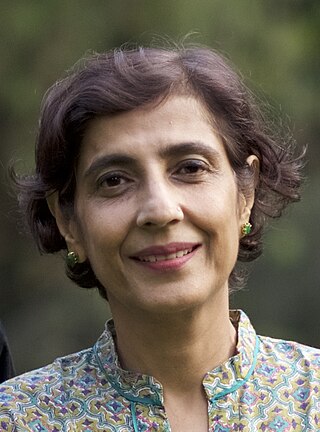
Ritu Sarin is an Indian film director, producer and artist based in Dharamshala, India. She is the director of the Dharamshala International Film Festival.

Tenzing Sonam is a Tibetan film director, writer and essayist based in Dharamshala. He works through his production company, White Crane Films, which he runs with his partner, Ritu Sarin.

Dr. Sarika Singh is perhaps the first Indian female master painter and teacher in the Buddhist tradition of Thangka Painting. Born on 13 August 1976, in New Delhi, she began her studies in the art of Thangka painting, in 1996, at the prestigious Norbulingka Institute in Dharamshala, Northern India under the tutelage of her master, Tempa Choephel. In the year 2015, she completed her Master’s degree in ‘Buddhist and Tibetan Studies’ from Punjab University, and ‘PhD’ from Central University of Himachal Pradesh in the year 2021.
Martin Brauen is a cultural anthropologist from Bern, Switzerland who specialises in Tibet, the Himalayas and history of religions.

Tenzin Tsetan Choklay is a Tibetan filmmaker.

David Francis Germano is an American Tibetologist and professor of Tibetan and Buddhist Studies at the University of Virginia (UVA), where he has dual appointments in its School of Nursing and Department of Religious Studies. Germano is a former board member of the International Association of Tibetan Studies, and currently serves as Editor-in-Chief for The Journal of the International Association of Tibetan Studies (JIATS), a journal of Tibetology.

Bringing Tibet Home is a 2013 documentary film produced and directed by Tibetan filmmaker Tenzin Tsetan Choklay about Tibetan contemporary Artist Tenzing Rigdol's art piece "Our Land Our people". The film premiered at the 2013 Busan International Film Festival in South Korea. This is a Tibetan-language film.

Sonam Dolma Brauen is a Tibetan-Swiss contemporary painter and sculptor.
Chen Danqing is a Chinese-American artist, writer, and art critic. He is well known for his realist paintings of Tibetans. Chen graduated from China Central Academy of Fine Arts.
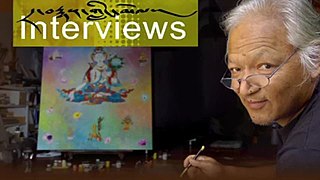
Karma Phuntsok is a Tibetan painter.

















